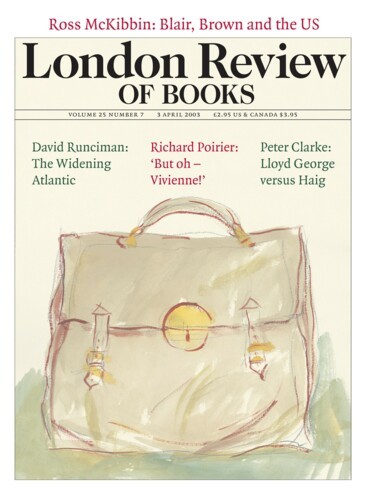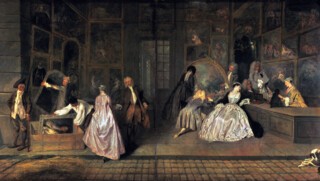Making pictures and dealing in them is an intimate business. In what other marketplace are the principal players – maker, buyer and seller – so close? Van Gogh’s brother Théo was a picture dealer. So was Vermeer, and so too was Vigée-Lebrun’s unsatisfactory husband. Dealers like Duveen achieved a way of life which challenged that of the millionaires they sold to. Money was so successfully laundered as painted canvas that the names Frick and Mellon now bring old pictures, not unfettered capitalism, to mind. The relation between artist and dealer is familial, and the squabbles and tensions domestic in character, if not in fact. The relation between dealer and buyer – no matter how friendly – is different, and of its nature confrontational. The dealer sets a price: the buyer decides when, and if, to pay it.
A tour of the commercial galleries offers glimpses of the art market at work. It is a way of looking at art unmediated by authorised taste. To be able to say ‘I could, in theory, own that’ – even if the picture is worth more than the house you live in – has its excitement. You can become concupiscent, like someone in a singles bar who knows that however unlikely success may seem, at least the desired object is not married and off the market. Unattached art must be judged without the crib of a museum label. It challenges you to make your own mind up. It allows you to think about possession.
The icon which best gives visual form to the disparate forces that unite the art of painting with the business of selling pictures is Watteau’s The Shop Sign. It is large – three metres wide – and was painted in 1721 in eight morning sessions. Watteau, now in the last stages of tuberculosis, had returned to Paris from England. He asked the dealer Gersaint if he could stay with him and, ‘to stretch his fingers’, paint something which would be shown outdoors – that is to say, in the open arched bay of Gersaint’s shop in one of the buildings which lined the Pont Notre-Dame. It was shown in the shop for only a fortnight, and admired by all Paris. It is now in Berlin.
The painting places one outside, on the roadway. You look past cobbles into an open bay. A glass door at the back leads onto another room. A portrait of Louis XIV is being crated up; a young woman who is being handed into the shop looks down at it. A bundle of straw for packing lies on the cobbles. The walls of the bay are lined with pictures which, without being specific, suggest the Venetian and Flemish canvases Watteau admired. (The only one which is identifiable was probably added by another hand.) There is a broad counter. A girl standing behind it shows a mirror to a young woman and two young men. A couple seen from the back (one in widow’s weeds) peer at a large, oval mythological scene on an easel. An assistant stands behind it and makes a gesture which suggests he is entering into the conspiracy of appreciation in which private pleasure becomes objective value – in other words, leading the couple from ‘I like it’ to ‘I’ll have it.’
Everything here finds echoes as one trawls London galleries from Lisson Street, close by the Edgware Road in the west, on to Bond Street and Cork Street, down to Saint James’s and out east to Hoxton Square. Underpinning it all is the one thing you cannot see: the relationship between artist and dealer. The Shop Sign exists because Gersaint gave Watteau brotherly as well as entrepreneurial support. In London one must infer such relationships from the list of ‘artists represented’ displayed by the gallery door or printed on the last page of exhibition catalogues. For the rest, The Shop Sign offers a visual epitome of a trade which has scarcely changed in its essentials over a couple of centuries.
Consider the elements. First, display – where to hang the pictures and how. The big opening in The Shop Sign puzzles me. Was it shuttered at night? Or were the pictures taken down and put up each day? Whichever way, merchandise was on display to the passer-by with no space wasted. Of all London galleries, the Lisson, in which a huge window lets you look into a large space a bit below street level, comes closest to Gersaint’s openness. It is no longer new, but its white walls and the Constructivist gawkiness of the façade still fit exhibitions of work which is shy of being pinned down in terms of received meanings of the word ‘art’. The virtues of the building are sculptural as much as architectural – the architect quotes American minimalists like Donald Judd as influences – and while the scale of the big front room is Gersaint-like, the display is not. Galleries which deal in contemporary modern art tend to follow the style of the public galleries, which space it out and seclude you and the work within an anonymous white box. In the Fine Art Society, on the other hand, you not only find furniture and pottery (Gersaint, too, sold more than pictures – on the counter, alongside the mirror, is a dressing case) but also walls close-packed with pictures.
Then there is light. The clear outdoor light Watteau wanted floods through big gallery windows on Cork Street. More surprisingly, there are still back and upstairs galleries in the Bond Street premises of the Fine Art Society, Agnew’s and Colnaghi which isolate you from the outside world but not from the light of day which drifts down from skylights.
The more mundane business of the trade in pictures – packing, storing and so forth, represented in The Shop Sign by the boy at work packing the King’s picture – now goes on in back rooms. In the Victoria Miro gallery I was shown a store with racked pictures. It has been screened off by one of the new walls which are part of the minimal alterations made to the original industrial space: a grandly achieved piece of non-design. Here, too, there is light from above; here, too, one can look into an office where the functions of Gersaint’s assistants are carried out. But modern pictures, large and quickly produced, soak up space; Gersaint must also have had off-site storage, but nothing like as much as an enterprise like Victoria Miro’s requires.
For a more literal expression of the separation of the exhibition function from the office function go east to White Cube in Hoxton Square. Here the original industrial brick and stucco box has been converted into two storeys of galleries. On top of it an equal volume of glass-walled offices and viewing rooms has been added. At dusk you look up at figures outlined against light and ask yourself if it really is a big Hirst dot-painting there against the office wall.
It is not quite as easy to wander the galleries as it was. There are now buzzers to be pressed and galleries which were once on the ground floor have moved upstairs. Annely Juda recently showed Hockney’s big watercolour landscapes and portraits on floors three and four, not ground and one. At White Cube you feel that the excitement is up in the glass box: that an upstairs/ downstairs division separates the dealer and the serious punter from the public.
The magic of representation – of pictures which look like real things – loses power in a world saturated with photographs and mechanical reproductions. The magic of the unique object, however, gains in strength. The hush of a dealer’s gallery is ecclesiastical. An act of transubstantiation takes place there. Paint, ink, paper and canvas are transformed by faith into something analogous to living creatures. The value which attaches to them can – up to a point – be measured in a price tag. That art sometimes lets you take a gamble is one of its attractions. The dealer, part priest part bookie, handles the bets.
Send Letters To:
The Editor
London Review of Books,
28 Little Russell Street
London, WC1A 2HN
letters@lrb.co.uk
Please include name, address, and a telephone number.


